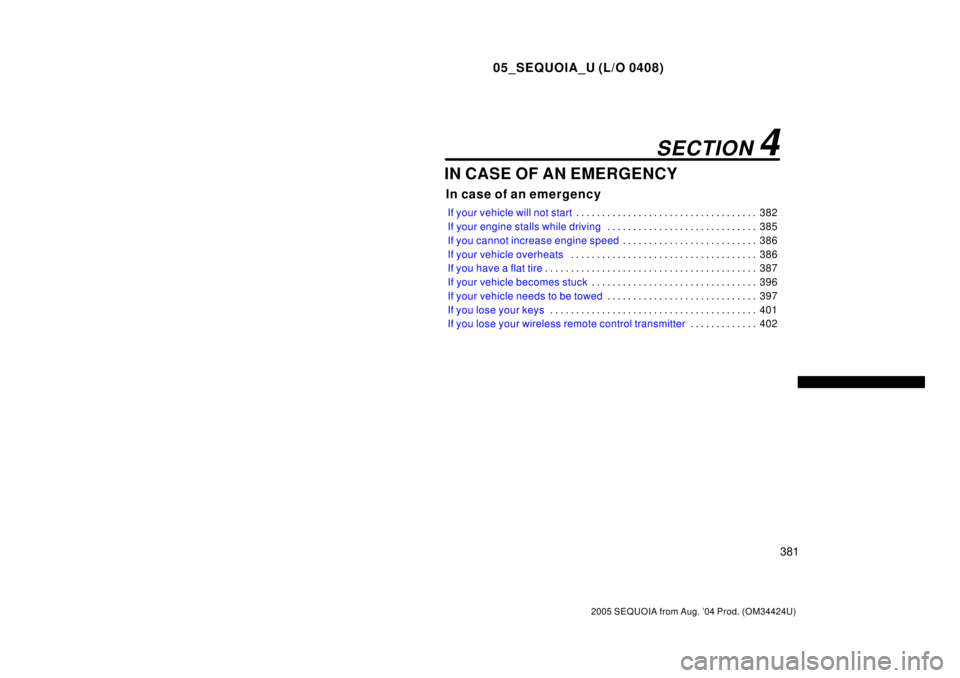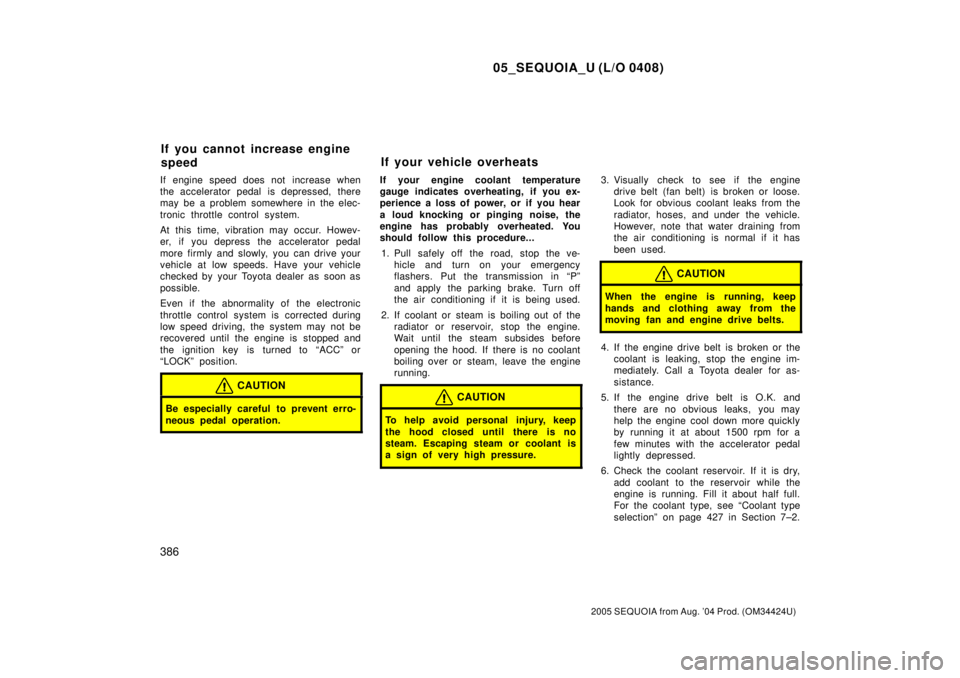Page 4240 of 4323

05_SEQUOIA_U (L/O 0408)
381
2005 SEQUOIA from Aug. '04 Prod. (OM34424U)
IN CASE OF AN EMERGENCY
In case of an emergency
If your vehicle will not start382 . . . . . . . . . . . . . . . . . . . . . . . . . . . . . . . . . . .
If your engine stalls while driving385 . . . . . . . . . . . . . . . . . . . . . . . . . . . . .
If you cannot increase engine speed386 . . . . . . . . . . . . . . . . . . . . . . . . . .
If your vehicle overheats386 . . . . . . . . . . . . . . . . . . . . . . . . . . . . . . . . . . . .
If you have a flat tire387 . . . . . . . . . . . . . . . . . . . . . . . . . . . . . . . . . . . . . . . . .
If your vehicle becomes stuck396 . . . . . . . . . . . . . . . . . . . . . . . . . . . . . . . .
If your vehicle needs to be towed397 . . . . . . . . . . . . . . . . . . . . . . . . . . . . .
If you lose your keys401 . . . . . . . . . . . . . . . . . . . . . . . . . . . . . . . . . . . . . . . .
If you lose your wireless remote control transmitter402 . . . . . . . . . . . . .
SECTION 4
Page 4241 of 4323

05_SEQUOIA_U (L/O 0408)
382
2005 SEQUOIA from Aug. '04 Prod. (OM34424U)
Before making these checks, make sure
you have followed the correct starting pro-
cedure given in ªHow to start the engineº
on page 362 in Section 3 and that you
have sufficient fuel. Also, check whether
the other keys will start the engine. If
they work, your key may be broken. Have
the key checked at your Toyota dealer. If
none of your keys work, there may be a
malfunction in the immobilizer system. Call
your Toyota dealer. (See ªKeysº on page
14 in Section 1±2.)
If the engine is not turning over or is
turning over too slowlyÐ
1. Check that the battery terminals are
tight and clean.
2. If the battery terminals are O.K., switch
on the interior light.
3. If the light is out, dim or goes out
when the starter is cranked, the battery
is discharged. You may try jump start-
ing. See ª(c) Jump startingº for further
instructions.
If the light is O.K., but the engine still will
not start, it needs adjustment or repair.
Call a Toyota dealer or qualified repair
shop.NOTICE
Do not pull± or push±start the ve-
hicle. It may damage the vehicle or
cause a collision when the engine
starts. Also the three±way catalytic
converter may overheat and become a
fire hazard.
If the engine turns over at its normal
speed but will not startÐ
1. Turn the ignition key to ªACCº or
ªLOCKº and try starting the engine
again.
2. If the engine will not start, the engine
may be flooded because of repeated
cranking. See ª(b) Starting a flooded
engineº for further instructions.
3. If the engine still will not start, it needs
adjustment or repair. Call a Toyota
dealer or qualified repair shop.If the engine will not start, your engine
may be flooded because of repeated
cranking.
If this happens, turn the ignition key to
ªSTARTº with the accelerator pedal fully
depressed, and hold the key at this posi-
tion for about 30 seconds. Then the
cranking hold function stops cranking au-
tomatically, and you can try starting the
engine with your foot off the accelerator
pedal.
If the engine does not start, wait a few
minutes and try again.
If the engine still will not start, it needs
adjustment or repair. Call a Toyota dealer
or qualified repair shop for assistance.
If your vehicle will not startÐ
(a) Simple checks(b) Starting a flooded engine
Page 4245 of 4323

05_SEQUOIA_U (L/O 0408)
386
2005 SEQUOIA from Aug. '04 Prod. (OM34424U)
If engine speed does not increase when
the accelerator pedal is depressed, there
may be a problem somewhere in the elec-
tronic throttle control system.
At this time, vibration may occur. Howev-
er, if you depress the accelerator pedal
more firmly and slowly, you can drive your
vehicle at low speeds. Have your vehicle
checked by your Toyota dealer as soon as
possible.
Even if the abnormality of the electronic
throttle control system is corrected during
low speed driving, the system may not be
recovered until the engine is stopped and
the ignition key is turned to ªACCº or
ªLOCKº position.
CAUTION
Be especially careful to prevent erro-
neous pedal operation.
If your engine coolant temperature
gauge indicates overheating, if you ex-
perience a loss of power, or if you hear
a loud knocking or pinging noise, the
engine has probably overheated. You
should follow this procedure...
1. Pull safely off the road, stop the ve-
hicle and turn on your emergency
flashers. Put the transmission in ªPº
and apply the parking brake. Turn off
the air conditioning if it is being used.
2. If coolant or steam is boiling out of the
radiator or reservoir, stop the engine.
Wait until the steam subsides before
opening the hood. If there is no coolant
boiling over or steam, leave the engine
running.
CAUTION
To help avoid personal injury, keep
the hood closed until there is no
steam. Escaping steam or coolant is
a sign of very high pressure.
3. Visually check to see if the engine
drive belt (fan belt) is broken or loose.
Look for obvious coolant leaks from the
radiator, hoses, and under the vehicle.
However, note that water draining from
the air conditioning is normal if it has
been used.
CAUTION
When the engine is running, keep
hands and clothing away from the
moving fan and engine drive belts.
4. If the engine drive belt is broken or the
coolant is leaking, stop the engine im-
mediately. Call a Toyota dealer for as-
sistance.
5. If the engine drive belt is O.K. and
there are no obvious leaks, you may
help the engine cool down more quickly
by running it at about 1500 rpm for a
few minutes with the accelerator pedal
lightly depressed.
6. Check the coolant reservoir. If it is dry,
add coolant to the reservoir while the
engine is running. Fill it about half full.
For the coolant type, see ªCoolant type
selectionº on page 427 in Section 7±2.
If you cannot increase engine
speedIf your vehicle overheats
Page:
< prev 1-8 9-16 17-24